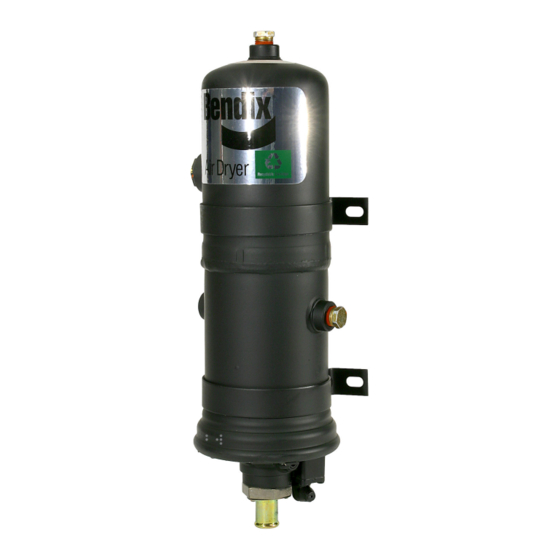BENDIX AD-1 AIR DRYER 매뉴얼 - 페이지 3
{카테고리_이름} BENDIX AD-1 AIR DRYER에 대한 매뉴얼을 온라인으로 검색하거나 PDF를 다운로드하세요. BENDIX AD-1 AIR DRYER 16 페이지.

The desiccant beads are held in place by steel perforated
plates and filter cloths. The top plate is held in place by a
spring, and the bottom plate rests on a shoulder
approximately 1/8" from the bottom of cartridge housing.
The end cover assembly is retained by a lock ring, cap
screws and retainers and houses the purge valve and heater
assembly if so equipped.
The heater and thermostat assembly prevent freeze-up in
the purge drain valve when the dryer is used in severe winter
conditions. The heater and thermostat assembly is standard
in the AD-2
™
air dryer and was optional equipment for the
AD-1
™
air dryer. The 12 volt, 60 watt and 24 volt, 60 or 120
watt DC heater and thermostat assembly has an operating
range between 45°F and 85°F .
NOTE: The heater and thermostat assembly provided with
™
the AD-2
air dryer has a 3/16" diameter threaded
electrical terminal protected by a boot. The AD-1
air dryer assembly incorporates a #16 gauge lead
wire. Both types are serviceable. The heater and
thermostat assembly should be connected to the
"on" position of the engine control or ignition switch
and protected with the proper size fuse. For details
on installation, please refer to the "Installation"
section.
OPERATION
The operation of the air dryer can best be described by
separating the operation into two cycles; the charge cycle
and the purge cycle.
Charge Cycle (Figure 3) Compressor in Compressing Cycle
- With the compressor in its "loaded" or compressing cycle,
air from the compressor enters the air dryer through the
discharge line. When the air, along with the water and
contaminants, enter the air dryer, the velocity or speed of
the air reduces substantially and much of the entrained liquid
drops to the bottom or sump of the air dryer. The initial air
flow is toward the bottom of the dryer, but air flow direction
changes 180° at the bottom of the air dryer, dropping some
water and oil.
The air now passes through the oil separator filter which
removes oil and foreign material but does not remove water
vapor. At this point, the air remains saturated with water.
The filtered air and vapors penetrate the desiccant drying
bed and the adsorption process begins. Water vapor is
removed from the air by the desiccant.
The unsaturated "dry" air passes through the ball check
valve and purge orifice into the purge volume. From the
purge volume air flows through an outlet check valve, and
into the first reservoir.
™
NOTE: The AD-1
outlet check valve. The single check valve in an
™
AD-1
air dryer installation would be located in the
line between the AD-1
first reservoir.
Purge Cycle; (Figure 4) When desired system pressure is
reached, the governor cuts out, pressurizing the unloader
cavity of the compressor which unloads the compressor
(non- compressing cycle). The line connecting the governor
unloader port to the end cover purge valve port (bottom of
the air dryer) is also pressurized, opening the exhaust of
the purge valve to atmosphere. With the exhaust of the
purge valve open, contaminants in the discharge line and
dryer sump are purged, or forced past the open exhaust out
to atmosphere.
The reverse air flows across the desiccant and starts the
removal process of moisture from the desiccant surface.
™
Dry air flowing from the purge volume through the purge
orifice and across the drying bed further dries the desiccant.
The combination of these reverse flows strips the water
vapor from the desiccant (drying bed). This normally takes
between 15-30 seconds.
The desiccant becomes activated from this cycle and is
now ready for another charge cycle, which occurs when the
compressor returns to the compressing cycle. It is for this
reason the air dryer must be purged for 30 seconds, after
receiving moisture saturated air for a maximum of 90
seconds from a 12 CFM compressor.
WARNING!
This air dryer is intended to remove moisture and other
contaminants normally found in the air brake system. Do
not inject alcohol, anti-freeze, or other de-icing substances
into or upstream of the air dryer. Alcohol is removed by the
dryer, but reduces the effectiveness of the device to dry
air. Use of other substances can damage the air dryer and
may void the warranty.
PREVENTIVE MAINTENANCE AND CHECKING
SERVICEABILITY
Important: Review the warranty policy before performing
any intrusive maintenance procedures. An extended
warranty may be voided if intrusive maintenance is
performed during this period.
Every 900 operating hours or 25,000 miles or every three
(3) months:
1. Check for moisture in the air brake system by opening
reservoirs, drain cocks, or valves and checking for
presence of water. If moisture is present, the desiccant
may require replacement; however, the following
conditions can also cause water accumulation and
should be considered before replacing the desiccant:
air dryer does not incorporate an integral
™
air dryer outlet port and the
3
